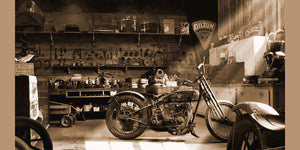Understanding the Important Parts of a Motorbike: A Comprehensive Overview for Lovers
For motorbike lovers seeking to elevate their riding experience and guarantee their bikes run efficiently, comprehending the vital elements of a motorbike is paramount. Each element, from the engine's detailed functions to the crucial role of the braking mechanisms, not only impacts efficiency yet also security and convenience. This overview will stroll via the essential components that every biker ought to be acquainted with, allowing informed selections in both upkeep and possible upgrades. As we begin this exploration, one must ask: exactly how does each part interact to create the smooth ride every lover looks for?
Engine Parts

The camshaft plays an important function in controlling the timing of the engine's shutoffs, guaranteeing the exact opening and closing required for reliable fuel and air intake, as well as exhaust expulsion. This timing is important to keeping optimal engine efficiency and performance. Furthermore, the carburetor or fuel injection system, relying on the motorbike design, is liable for mixing air with gas in the right ratio for combustion.
The air conditioning system, either air or liquid-based, functions to preserve the engine's temperature within operational restrictions, avoiding overheating and guaranteeing longevity - motorcycle parts nz. Each element, carefully made and incorporated, contributes to the smooth procedure of the engine, defining the motorbike's power result and general efficiency
Transmission System
Indispensable to the bike's performance, the transmission system guarantees reliable power transfer from the engine to the wheels. This system makes up a number of critical parts, consisting of the clutch, transmission, and last drive, each playing an important role in converting the engine's power into activity. The clutch, typically run by a hand bar, offers to disengage the engine and involve from the transmission, enabling smooth gear adjustments and controlled acceleration.
The transmission, commonly referred to as the transmission correct, has a set of equipments that motorcyclists can by hand shift via to adjust the bike's rate and torque output. These gears are arranged in a sequence that enables the motorbike to accelerate smoothly and preserve optimum engine efficiency throughout various rates. Many motorbikes use a consecutive gearbox, requiring the cyclist to move gears in a fixed order.
Braking Mechanisms
While comprehending the transmission system is crucial to taking advantage of a motorcycle's power, just as important is the capacity to regulate and stop that power efficiently, which is where braking systems enter into play. Brakes are essential for safety and security and performance, giving the biker with the essential control to navigate various terrains and conditions. Typically, motorcycles feature two kinds of braking systems: disc brakes and drum brakes.
Disc brakes are a lot more prevalent in contemporary bikes as a result of their remarkable performance. They include a brake disc, caliper, and pads. When my link triggered, the caliper presses the brake pads against the spinning disc, transforming kinetic power right into heat, thus slowing the wheel. This system offers far better warmth dissipation, consistent performance, and improved quiting power, particularly in damp problems.
Alternatively, drum brakes, though much less common, are still found in some bikes. They function by pressing brake footwear versus the internal surface of a drum connected to the wheel. While you could try these out usually less effective in heat dissipation and quiting power, drum brakes are easier and a lot more economical.
Recognizing these stopping systems' nuances enables motorcyclists to keep their motorcycles correctly and appreciate the design that ensures secure and effective stopping.
Suspension and Guiding
Suspension and steering systems are vital components that considerably affect a motorcycle's handling and experience comfort. The suspension system, containing forks at the front and shock absorbers at the back, soaks up road irregularities, enhancing security and control. Front forks, inverted or normally telescopic, compress and rebound to reduce influences, while back shock absorbers keep tire call with the road, crucial for traction and safety.
Guiding, focused around the handlebars, connects the biker to the motorcycle's directional control. The steering head bearings make certain smooth procedure, allowing specific maneuverability. Appropriate alignment and maintenance of these bearings are essential for predictable guiding reaction and decreasing cyclist exhaustion.
The suspension's adjustability is another essential element; preload, damping, and rebound setups allow modification to fit different riding styles and conditions. This versatility is crucial for enhancing performance, whether browsing metropolitan streets or dealing with tough routes. Advancements like electronic suspension systems supply real-time changes, boosting trip quality throughout diverse terrains.

Electric Systems
After ensuring a smooth and controlled experience via effective suspension and steering systems, focus turns to the electric systems, a crucial aspect of modern motorbikes. These systems play an essential duty not just in starting the engine however discover this also in powering different parts that improve the functionality and safety and security of the motorcycle.
At the heart of a bike's electrical system is the battery, which shops electrical power required for beginning the engine and powering supporting systems - moto parts nz. The alternator or generator, coupled with the rectifier-regulator, guarantees the battery continues to be charged while the bike functions, converting mechanical energy right into electric energy and preserving voltage levels
The ignition system, an additional essential element, is in charge of sparking the air-fuel mix in the engine's cyndrical tubes. Modern motorbikes frequently utilize a digital ignition system, offering higher effectiveness and integrity contrasted to typical systems.
Illumination systems, including headlights, tail lights, and indications, are additionally important, ensuring visibility and safety for the rider. Additional electronic elements such as sensors, control devices, and shows add to sophisticated attributes like fuel injection monitoring, anti-lock stopping systems (ABDOMINAL), and electronic control panels, better boosting the riding experience.
Conclusion
A complete understanding of a bike's crucial parts, consisting of the engine, transmission system, braking devices, suspension, guiding, and electrical systems, is crucial for fanatics aiming to enhance convenience, security, and efficiency. Mastery of these components enables informed decisions pertaining to maintenance and upgrades, ultimately boosting the riding experience. By incorporating this knowledge, bikers can guarantee their bikes operate at peak efficiency and dependability, thus making the most of both pleasure and long life of their automobiles.
For motorcycle fanatics looking to raise their riding experience and ensure their bikes run smoothly, understanding the crucial components of a bike is vital.Important to the bike's performance, the transmission system guarantees effective power transfer from the engine to the wheels.While understanding the transmission system is crucial to harnessing a bike's power, just as essential is the ability to control and stop that power successfully, which is where braking devices come right into play. Normally, bikes feature 2 types of stopping systems: disc brakes and drum brakes.
A comprehensive understanding of a bike's essential components, consisting of the engine, transmission system, braking systems, suspension, guiding, and electric systems, is essential for fanatics aiming to optimize convenience, safety, and efficiency.